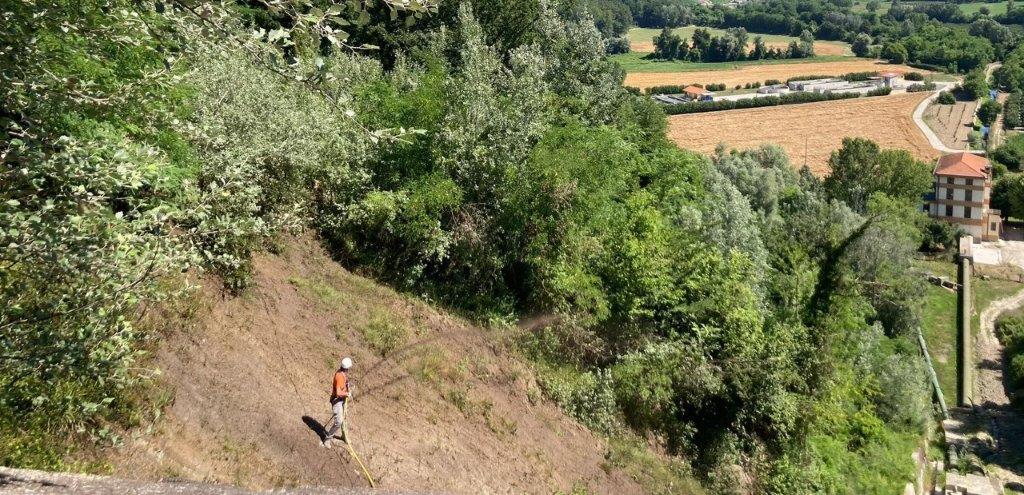To fight soil erosion, we’re going to the root of the problem
The presence of renewable energy facilities can sometimes bring about unexpected benefits, such as using deeply-rooted plants to prevent soil erosion at EGP sites. An example of environmental technology called Prati Armati®.
Sometimes, the most innovative solutions are actually rooted in the past. It’s precisely in this spirit that Enel Green Power has decided to deal with the issue of soil erosion and hydrogeological instability, a process which is occurring more and more often, largely due to increasing levels of deforestation, overbuilding and urbanization – and the situation is likely to worsen with climate change and the extreme weather events it provokes.
Slopes, road and railroad embankments, river and stream banks, degraded areas, quarries, mines and landfills are all places where the consequences of soil erosion are commonly found.
But the issue can also cause problems where renewable and clean energy facilities are located, because although the construction of such sites takes into consideration the various pedological, agronomic and geotechnical conditions of the soil, it is still possible for the soil conditions to change over time. It is for this reason that EGP is testing a new solution to tackle soil erosion, one that is actually very old and entirely natural: a seed mix consisting of several deep-rooting herbaceous plants. These are non-GMO plants with roots that can reach up to 4-5 meters in length; they are resistant to aridity, able to adapt to any type of soil, with various degrees of acidity (pH), and in any climate, and able to withstand temperatures ranging from -40°C to +60°C. These non-invasive herbaceous plants are also capable of capturing up to 400% more carbon dioxide than other types of plants.
“Innovation also means transferring solutions from one sector to another, generating fruitful connections between apparently very different fields. In this case, we’re linking innovative agronomic solutions with the electricity generation industry, the aim being to validate new, completely green methodologies that can better integrate our renewable assets into the surrounding environment.”
Nicola Rossi, Head of Innovation,Enel Global Power Generation
This natural, sustainable “invention”, which utilizes none of the geopolymers, techniques or products that are typically associated with hydraulic engineering, was devised by an Italian company that has chosen a decidedly evocative name for itself: Prati Armati® (literally meaning “Reinforced Meadows”).
The herbaceous plant seeds are carefully selected according to the area in which they are to be used and their compatibility with the local flora. Once sown, they take root easily thanks to the sowing method used: they’re “sprayed” onto the ground inside an aqueous solution, which acts as a sort of natural glue.
“This natural and completely sustainable solution is able to stop soil erosion, while simultaneously facilitating the renaturalization of problematic slopes, fostering biodiversity and accelerating ecological succession.”
Miriam Di Blasi, Head of Environment and Impacts Mitigation Innovation, Enel Green Power
EGP’s Operation & Maintenance team have already used this approach, employing it in 2018 to combat soil erosion at the Maida wind power facility in Calabria, Italy. Now the Innovation EGP team is looking to test it in off-limits cases, because successful testing could open the way for the approach to be adopted across the entire Group. To this end, the first innovative use of this approach concerned an area adjacent to a penstock of the Narzole hydropower plant, in the province of Cuneo. The area of land where the successful test was carried out is particularly steep and devoid of vegetation. However, with woods and truffle grounds located in the surrounding environment, it was necessary to experiment with a totally natural solution that would respect all other vegetation.
“Prati Armati® turns infrastructure and facilities into powerful CO2 absorbers, which are protected from hydrogeological instability forever and require no maintenance; this is achieved by using only deeply-rooted herbaceous plants. The energy costs of this solution are between 10 and 100 times lower than the traditional techniques that have been employed until now and it can be implemented very quickly.”
Marcello Zarotti, Managing Director, Prati Armati srl
Testing will continue over the next several months at other sites. At the Castelmauro wind power facility, in Molise, which is currently under construction, the aim of the operation will be to mitigate the impact of the road infrastructure being built on lime stabilized embankments, thus enabling it to better integrate into the agricultural environment.
The Prati Armati® slogan is “Nature saves itself.” And, indeed, this solution minimizes the risks associated with hydrogeological instability, stabilizes slopes which are a landslide risk, and makes the natural landscape once again hospitable to life, thus preserving biodiversity. It can also act as a containment measure, thanks to phytocapping, for the remediation of contaminated areas by isolating contaminated materials or soils from the surrounding environment and storm water.
Furthermore, it’s an entirely maintenance-free technology. The herbaceous plants do not require cutting, they grow in depth but not so much in height, and can also serve as food for livestock without the need for seeds to be resown.

 Prati Armati Srl
Prati Armati Srl

